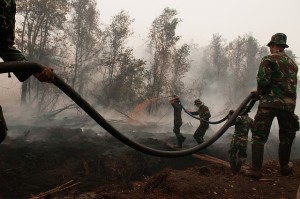Originally posted at CIFOR’s Forests News
 In September 2015, large fires flared up in the forest, degraded lands and peatlands of Central Kalimantan, South Sumatra, and other parts of Indonesia. Fires continue to be lit.
In September 2015, large fires flared up in the forest, degraded lands and peatlands of Central Kalimantan, South Sumatra, and other parts of Indonesia. Fires continue to be lit.
As of late October, more than 115,000 fires are active across much of the archipelago, but concentrated in the provinces of Riau and Jambi on the island of Sumatra, as well as Central and West Kalimantan on Borneo.
The Indonesian Minister of Environment and Forestry has said fires have burned some 1.7 million hectares of land in Sumatra and Borneo.
Fires are an annual, normal event in Indonesia’s peatlands and forests, peaking around September or October. But deforestation and repeated burning have made the landscape considerably more fire-prone.
The fires are being made worse by an exceptionally intense El Niño event, which is predicted to persist into early 2016.
However, research by CIFOR shows that major air pollution events are no longer restricted to drought years, as peatland deforestation and ongoing land degradation continue to make large parts of the landscape even more susceptible to burning.
Meanwhile, the costs of the fires and haze continue to mount. The root causes are complex. Reaching long-term solutions to prevent future fires will take time, coordination and solid evidence.
How fires start in Indonesia and why they continue
- Fires in peatland are extremely difficult to put out, often smoldering for days or weeks, threatening to reignite the landscape. Only the heavy downpours of the wet season can truly extinguish them.
- Peat is a mixture of soil and partly decayed vegetation, formed in the wetlands that line the coasts of the Indonesian archipelago.
- Deforestation exposes the peat beneath the trees and together with drainage, dries the material. Clearing and repeated burning also encourage the growth of ferns and shrubs that are themselves more fire-prone.
- Fire is a cheap and easy way for smallholder farmers and large companies to clear land for crops such as oil palm.
- Traditionally, local farmers use slash-and-burn techniques to open up small patches of rainforest for crops and livestock.
- Large-scale developments contribute to expanding use of fires by communities as developments attract migrants and improve access to previous remote areas.
- Weak governance and poor land planning then allow land speculators and other investors to move in.
- Unclear or unenforced land tenure sets the stage for conflict between local smallholders, migrants, government agencies, communities and corporations. Fire is often used to stake claims.
- Although satellite observations show that about 1 in 5 fires start inside of oil palm concessions, recent research by CIFOR suggests the story is more complicated, as local communities also occupy land inside concessions, and fires ignited outside can spread into concessions.
- Indonesia’s palm oil industry is driven by global demand and investment by Malaysian and Singaporean companies, among others. In 2014, Indonesia supplied about 52 percent of the world’s palm oil, which is used in a wide range of products: from potato chips to cosmetics to cooking oil to toothpaste.
- Palm oil is a major spur of economic growth in Indonesia and the region. Together, about 11 million hectares of oil palm plantations produce 33 million tons of oil, generating US$ 21 billion in 2014.
Read more at CIFOR’s Forests News











